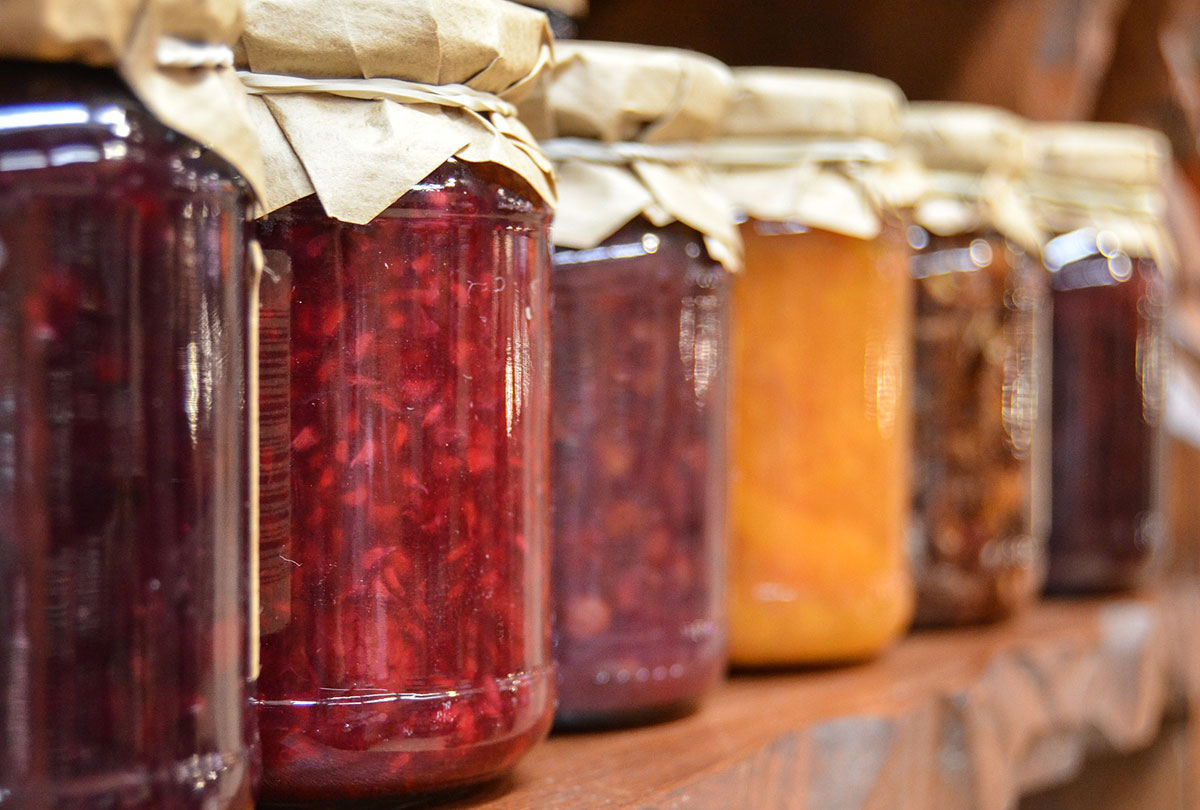
Maine Extension Homemakers Newsletter, Fall 2021
Table of Contents
- Presidential Ponderings from Bea LaPlante
- Around the State
- University of Maine COVID 19 Updates
- Mark Your Calendar!
- Meet Your County Advisors
- Officers Needed
- Remember This?
- Make the Connection: Join Extension!
- Maine Home Garden News, Fall 2021
- Mushrooms on Lawns
- Seasonal Recipes for Cool Autumn Nights
- Safe Homemade Food Gifts
- Spiced Apple Cider in the Slow Cooker
Presidential Ponderings from Bea LaPlante

Hello Homemakers!
It does not seem possible that summer is over and fall has started. Look out, and pretty soon we will be having our first snow storm! I do not know how many of you have been having group meetings, but hope you have been keeping safe by doing what the University of Maine has advised. Keep wearing those masks!
We are looking for new state officers for the coming years, so if anyone is interested in holding a state office, please let me know. We have someone from Aroostook County interested in taking on the role of Treasurer, but still need volunteers for Secretary, Vice President, and President.
I would like to say thank you to all our group leaders who have seen their counties through this pandemic. A big thank you to Lisa, Cathy, Zabet, and Angela for all the help and standing by the Homemakers.
If any of you have any questions, we are all here for you.
Have a great fall,
Bea
Around the State
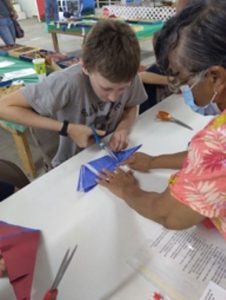
Aroostook County Extension Homemakers oversaw the exhibit hall at the Northern Maine Fair and one club instructed youngsters how to make Patriotic May Baskets. Pictured at right is Rose Harris of the Caribou Homemakers.

Cumberland County Extension Homemakers set up a display at the Cumberland Fair showing the projects they completed. The theme for the display was “Then and Now” showing the differences and similarities between homemaking in the early years of the program and what it looks like today. The display even included a small exhibit showing how Homemakers is sometimes described as “4-H for Adults.” County Advisor, Cathy Bartlett Gray, along with 4-H member Maddie G. hosted an activity table for fair-goers where passersby could make a handmade peppermint tea bag and learn a few facts about the benefits of peppermint tea.
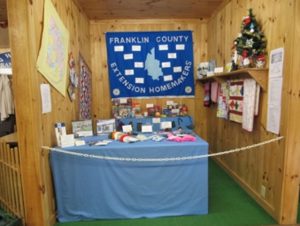
Franklin County Extension Homemakers are busy preparing for training on the new report forms on October 21 and making ornaments for the Rotary Tree Auction. Their display at the Farmington Fair highlighted information directly from their 2019 County report. Photo by Lois King and used with permission.
Hancock County Extension Homemakers will hold their fall meeting on October 12 and will have a speaker on sun dried blueberries and making fruit leather and will also hold a silent auction.

Oxford County Extension Homemakers were inspired to collaborate with local 4-H members by setting up a display in the 4-H Exhibit Hall this year. Trying to bridge the gap between the youth in 4-H and the more experienced adults in Homemakers, members wanted to show how both programs have like-minded missions and similar activities. A “Make a Handmade Peppermint Tea Bag” activity table hosted by county advisor, Cathy Gray, had many interested people stop by to participate. It’s fair to say that folks loved the fair this year!
Somerset County Extension Homemakers will see Blue Birds flying again at their County Fall Meeting on October 18. They will have a speaker talk about birds and bluebird houses will be raffled as door prizes.
University of Maine COVID 19 Updates
The University of Maine System adheres to guidance from the Maine Centers for Disease Control and the Office of the Governor of Maine regarding COVID 19. Extension offices are now open to the public, but face masks are required for entry into the building. Conference rooms are open to Extension staff and volunteers, though masks are required and social distancing is expected, regardless of vaccination status. Contact your local UMaine Extension county office to make arrangements. There is no expectation for social distancing or masks for outdoor gatherings.
Mark Your Calendar!
October is National Apple Month, as well as National Book Month and National Health Literacy Month. It is also Domestic Violence Awareness Month.
November is National Banana Pudding Lovers month, as well as National Gratitude Month and National Raisin Bread Month.
December brings us National Pear Month and Universal Human Rights Month.
Meet Your County Advisors
This month, we are saying goodbye and good luck to former Hancock County Advisor, Zabet Neucollins. Zabet has left Extension to fulfull her career goals at Women for Healthy Rural Living, a non-profit located in Milbridge. We will surely miss her energy and her smile!
With Thanksgiving coming up, pie is on our minds! What kinds of pie do your advisors enjoy most?
Angela Martin, Statewide support
angela.martin@maine.edu
Favorite pie: Gotta go with blueberry!
Cathy Gray, York, Cumberland, and Oxford
cathy.gray@maine.edu
Favorite pie: Smooth and Sweet Buttermilk Pie!
Lisa Fishman, Aroostook, Franklin, Somerset and Hancock
lisa.fishman@maine.edu
Favorite pie: Nothing beats a good lemon meringue!
Officers Needed
The State Board of the Maine Extension Homemakers Council is seeking nominations for leadership positions in 2022.
If you have ever considered holding an officer position on the MEHC Board, this is the perfect time to make that dream a reality. The MEHC Board will need to replace its President, Vice President, Secretary and Treasurer in 2022, which means we need YOU. Your County President and your County Advisor have application forms for you to fill out upon request.
Remember This?
What is this gadget? If you think you know, let us know!
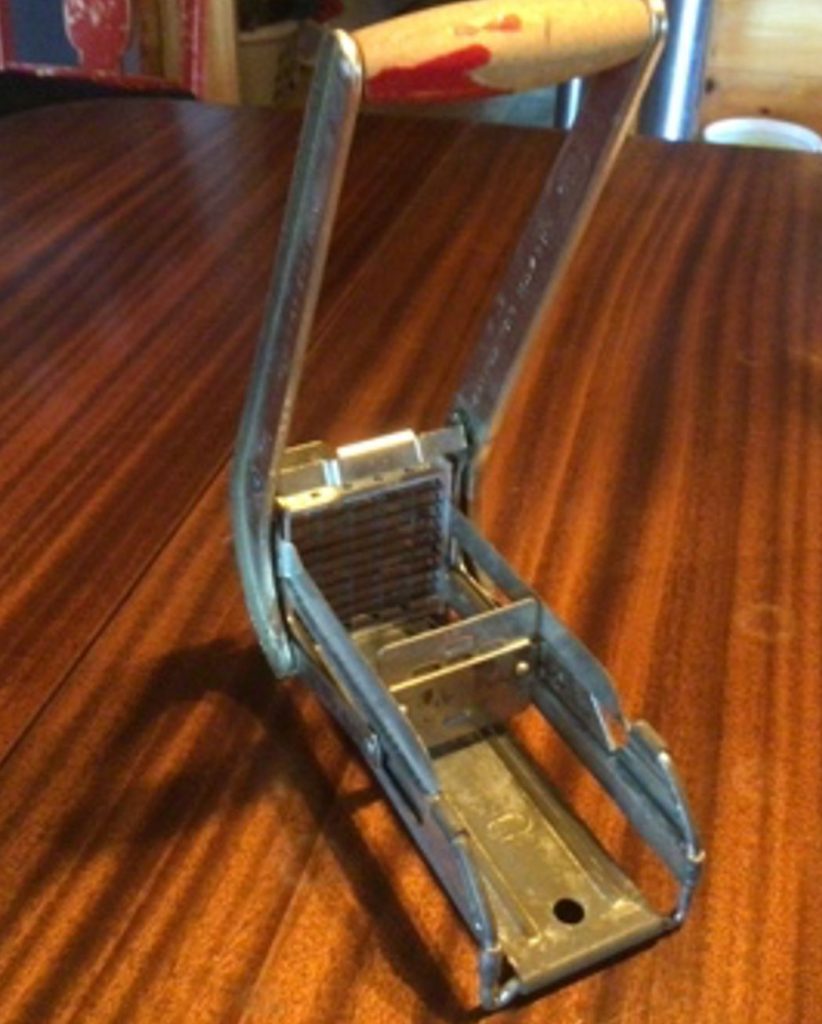
From last month: July 20, 1969, Apollo 11 lands on the moon.

Make the Connection: Join Extension!
Traditional Extension Homemaker clubs are in desperate need of new members and new clubs. Your advisors have been discussing options to form a new type of club that would consist of 4-H members who have “aged-out” of 4-H clubs, and are still looking for a meaningful connection to the University of Maine Cooperative Extension. Stay tuned for more information as it develops!
Maine Home Garden News, Fall 2021
Maine Home Garden News is an online monthly newsletter bursting with information all home gardeners should know about. Subscribe to receive this newsletter in your inbox each month and learn all about what’s eating your garden, what tools are hot, what cookbooks will help you use up all that produce, and what the experts are saying across the nation about all things gardening! Check out the November issue!

Mushrooms on Lawns
By Dr. Seanna Annis, University of Maine Associate Professor of Mycology and Associate Extension Professor
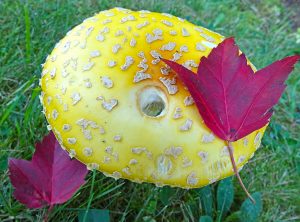
With the rain we have been getting this fall, we are seeing fungi popping up in peoples’ yards, fields, and woods all over the state. These fungi typically have been present for years, growing underground until they have sufficient nutrients and water to produce their fruiting body or mushroom where we can see it. The fruiting body is equivalent to a fruit on a plant and helps the fungus disperse itself through spores to new environments. Most fruiting bodies last less than a week since they release spores that are dispersed by wind for a few days and then rot from other fungi or bacteria eating them. The fungus under the surface of the ground supporting the production of the fruiting bodies consists of fine strands called hyphae. The hyphae form a much larger and longer living structure than the fruiting body and can persist for years or decades.
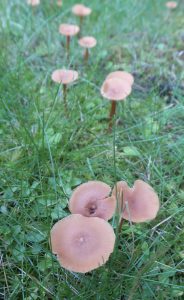
Most of these fungi are providing valuable services to the plants near them. Many of these fungi are breaking down dead plant material and returning valuable nutrients, such as nitrogen and phosphorus, to the soil for plants to use. Some fungi have a more direct role in interacting with plants and are in a mutually beneficial symbiosis with plant roots, particularly shrubs and trees, called mycorrhizae. Mycorrhizal roots have fungus growing around or in the roots in close contact with plant cells and the hyphae extended out into the soil around the plant. The fungus collects nitrogen, phosphorus, other nutrients and water and gives it to the plant through the mycorrhizal roots. The plant, in turn, gives plant sugars to the fungus to grow. It is estimated that 90% of plant families have mycorrhizal roots. Many mycorrhizal fungi also protect the plant against fungi that cause root rot or other organisms, such as bacteria and plant pathogenic nematodes (microscopic worms), and improve soil quality. Without mycorrhizal fungi, many plants do not thrive and many cannot grow in the forests, bogs, and other ecosystems in Maine.
Many landowners ask how to get rid of the fruiting bodies on their lawn. Unfortunately there is no way of doing this without removing all of your plant. Spraying fungicides on the lawn will not penetrate down to where these fungi are growing and may damage beneficial fungi and plant roots. Fungi are inhabitants of all soil types and usually are interacting in a beneficial way with nearby plants. The fruiting bodies should only be around for about a week or two and can be safely removed and thrown in the compost or garbage. Do NOT eat any fungus unless you have confirmed with a mushroom expert that it is edible. If you eat most of the fruiting bodies growing on lawns, they will give you diarrhea and vomiting, that can be severe, but eating the fruiting bodies of some fungi can cause severe poisoning with damage to the major organs, particularly the liver and kidneys, and can result in death.
Can Tabs? Yes, Please!
The Maine Extension Homemakers collected can tabs for Shriners for many years, and the project was overseen by Bunny Worster. When the Shriners could no longer take can tabs, Bunny passed the can-tab-baton to Barbara Lord, who found a new non-profit who would accept the can tabs, The Travis Mills Foundation. Barbara has now passed the can-tab-baton to Lois King, and Lois will be doing some research on whether the Travis Mills Foundation is still accepting can tabs, or if a new recipient can be determined. Whichever way this all goes, KEEP COLLECTING THOSE CAN TABS, LADIES and GENTLEMEN! Thank you to Barbara Lord for shepherding the can tabs through a global pandemic. We appreciate all you have done for the Maine Extension Homemakers.
Seasonal Recipes for Cool Autumn Nights
Recipes courtesy of University of Maine Cooperative Extension Expanded Food and Nutrition Education Program.
Apple Squash Casserole
Serves: 8 | Serving size: 1/2 cup
Ingredients:
- 3 apples (~4 cups sliced), cut into ½-inch slices
- 1 medium butternut squash (~6 cups sliced), peeled and cut into ½-inch slices
- 1 teaspoon nutmeg
- 1.5 teaspoon cinnamon
Directions:
- Preheat oven to 350 degrees F.
- Cut apples into ½-inch slices leaving the skin on.
- Peel, cut the squash in half*, scoop out the seeds, and cut the squash into ½-inch slices.
- Tip: cut the ends off of squash and microwave on high for ~30 seconds on a microwave safe plate to peel easier.
- Alternate layers of squash, apples, nutmeg, and cinnamon in an 8 x 8-inch pan, ending with apples on the top layer.
- Cover pan with aluminum foil and bake at 350 degrees F for about 45-60 minutes, or until squash is tender.
- Remove foil and bake another 10-15 minutes to remove any excess liquid that might have accumulated.
- Cool slightly before serving.
*Tip: For easier cutting and peeling of the butternut squash, cut the ends off and microwave on high for about 30 seconds.
Microwave Scalloped Potatoes
Serves: 4 | Serving Size: 1 cup
Ingredients:
3 medium potatoes, peeled and sliced
1 teaspoon flour
1/2 teaspoon salt
1/4 teaspoon pepper
2 teaspoons soft butter
1/4 cup grated low-fat Swiss cheese
1 cup fat-free milk
Directions:
- Grease a 2-quart casserole dish (microwavable).
- Cover the bottom of the dish with a layer of potatoes. Dot with some (about ⅓) of the butter. Sprinkle with part of the flour, salt, and pepper. Repeat layering until all potatoes are used, about 2–3 layers.
- Sprinkle cheese over top layer; pour milk over potatoes. Cover the dish with plastic wrap, tightly cover so plastic wrap doesn’t touch food, then lift one corner to allow ventilation.
- Microwave on high for 10–12 minutes.
- Place under broiler 2–3 minutes to brown.
For more healthy, easy-to-make recipes, see UMaine Extension’s tested Recipes.
Safe Homemade Food Gifts
By Marlene Geiger, Iowa State University. Adapted with permission from Iowa State University Extension and Outreach’s AnswerLine, blogs.extension.iastate.edu/answerline.
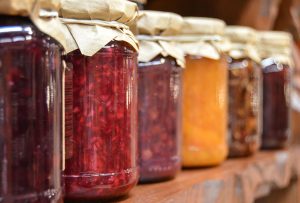 Homemade food gifts are thoughtful holiday (or anytime) gifts. But how do you know if the food gift you are giving or receiving is safe to eat? Not everything that is made commercially can be made at home safely. This is especially true when it comes to canned food gifts—jams and jellies, butters, soups, pickles, salsa, pesto, barbecue sauce, flavored vinegars or oils, and more.
Homemade food gifts are thoughtful holiday (or anytime) gifts. But how do you know if the food gift you are giving or receiving is safe to eat? Not everything that is made commercially can be made at home safely. This is especially true when it comes to canned food gifts—jams and jellies, butters, soups, pickles, salsa, pesto, barbecue sauce, flavored vinegars or oils, and more.
The National Center for Home Food Preservation offers these guidelines to evaluate the safety of home-canned gifts:
LOW RISK. Fruit jams and jellies, fruit spreads, and whole fruits like peaches and pears are low-risk because their natural acidity and high sugar content provide an extra measure of safety. Jams or jellies made with artificial sweeteners or with gelatin would be exceptions. Those made with artificial sweeteners must be made with an appropriate gelling agent and stored per directions; gelatin-based products must be refrigerated or frozen.
HIGH RISK. Low-acid meats, vegetables, and mixtures pose a higher risk because these products can support the growth of the botulism bacteria if improperly prepared and/or processed. These products must be prepared with a tested recipe and processed in a pressure canner.
HIGHEST RISK. Mixtures of acidic and low-acid foods such as salsas, some pickled products, pesto, soups, sauces, herb and oil mixes, and cream-based soups are of highest risk for potential botulism if they are not prepared with a tested recipe and properly processed in a jar of proper size. There are NO tested recipes for canning vegetable-based butters, such as Pumpkin Butter, pesto, fudge/chocolate sauce, cream soups, or herb/vegetable oils.
For any home-canned product to be unquestionably safe, the product must be prepared using a USDA approved and TESTED RECIPE explicitly followed without exception. Further, gifts canned in decorative, untested jars or with unconventional lids should also be suspect. A sealed lid doesn’t mean a canned product is safe.
Another NO in the world of canned gifts is the so called “canned” breads and cakes. Referring to a previous blog, ‘Home-Canned’ Cakes and Breads for Gift Giving — A Big NO, these products involve no canning per se and are not safe in any way. “Many cake and quick bread recipes often have little or no acid resulting in a pH range above 4.6, a pH level that will support the growth of pathogenic organisms that cause foodborne illnesses. Of greatest concern is the microorganism Clostridium botulinum (botulism) growing in the jars. Conditions inside the jar are ripe for hazardous bacterium given that cake and bread recipes may include fruits, liquids, or vegetables that increase moisture content AND the practice does not remove all the oxygen from the jar. The two factors create a rich environment for microorganisms to thrive.”
If you are the recipient of a food gift, be gracious and thankful for the gift as it is the thought that counts. If you are comfortable, it is appropriate to ask a few kind questions if you know the giver well; it may seem ungrateful to ask the same of a lesser-known acquaintance. If there is any doubt, throw it out and don’t bring up the issue again.
If you are the giver of a homemade food gift, particularly home canned food, know without a doubt that the gift you are giving is explicitly safe—it has been prepared with a USDA approved and tested recipe and processed appropriately. Jarred gifts should also include a clean, rust-free ring to avoid accidental loosening of the flat lid.
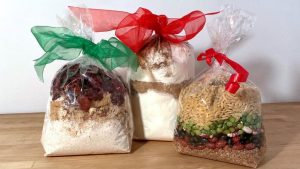 Handmade gifts are the best kind, particularly when they’re edible. They are very personal and truly an act of love. Besides canned products, consider frozen or dehydrated foods, dry mixes in a jar or bag, sweet or savory nut mixes, candy, flavored popcorn, fresh breads or rolls, cookies, crackers, granola, gingerbread anything, or chocolate bark combinations just to name a few and, all of which, would be without the potential of harmful microorganisms to cause a foodborne illness or worse.
Handmade gifts are the best kind, particularly when they’re edible. They are very personal and truly an act of love. Besides canned products, consider frozen or dehydrated foods, dry mixes in a jar or bag, sweet or savory nut mixes, candy, flavored popcorn, fresh breads or rolls, cookies, crackers, granola, gingerbread anything, or chocolate bark combinations just to name a few and, all of which, would be without the potential of harmful microorganisms to cause a foodborne illness or worse.
Here’s to keeping the holidays ‘jolly’ with safe food gifts!
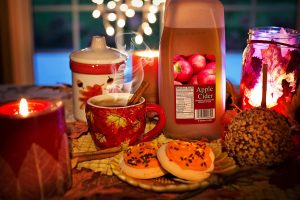 Spiced Apple Cider in the Slow Cooker
Spiced Apple Cider in the Slow Cooker
- 2 quarts apple cider
- 1/4 cup packed brown sugar
- 2 cinnamon sticks
- 1 teaspoon whole cloves
- 1/8 teaspoon ground ginger
Combine all ingredients in a slow cooker and simmer on low for at least 2 hours.
Information in this publication is provided purely for educational purposes. No responsibility is assumed for any problems associated with the use of products or services mentioned. No endorsement of products or companies is intended, nor is criticism of unnamed products or companies implied.
© 2021
Call 800.287.0274 (in Maine), or 207.581.3188, for information on publications and program offerings from University of Maine Cooperative Extension, or visit extension.umaine.edu.
The University of Maine is an EEO/AA employer, and does not discriminate on the grounds of race, color, religion, sex, sexual orientation, transgender status, gender expression, national origin, citizenship status, age, disability, genetic information or veteran’s status in employment, education, and all other programs and activities. The following person has been designated to handle inquiries regarding non-discrimination policies: Director of Equal Opportunity, 101 North Stevens Hall, University of Maine, Orono, ME 04469-5754, 207.581.1226, TTY 711 (Maine Relay System).
